Articles
- Page Path
- HOME > J Korean Acad Nurs > Volume 43(1); 2013 > Article
-
Original Article
- Analysis of Burnout and Job Satisfaction among Nurses Based on the Job Demand-Resource Model
- Young-Hee Yom
-
Journal of Korean Academy of Nursing 2013;43(1):114-122.
DOI: https://doi.org/10.4040/jkan.2013.43.1.114
Published online: February 28, 2013
Red Cross College of Nursing, Chung-Ang University, Seoul, Korea.
- Address reprint requests to: Yom, Young-Hee. Red Cross College of Nursing, Chung-Ang University, 224-1 Heukseok-dong, Dongjak-gu, Seoul 156-755, Korea. Tel: +82-2-820-5700, Fax: +82-2-824-7691, yhyom@cau.ac.kr
• Received: July 19, 2012 • Accepted: November 8, 2012
© 2013 Korean Society of Nursing Science
Figure & Data
REFERENCES
Citations
Citations to this article as recorded by 

- Nursing staff and supervisors perceptions on stress and resilience: a qualitative study
Madeleine Helaß, Anja Greinacher, Melanie Genrich, Andreas Müller, Peter Angerer, Harald Gündel, Florian Junne, Christoph Nikendei, Imad Maatouk
BMC Nursing.2025;[Epub] CrossRef - Toxic university: the relationships between instructor job satisfaction, burnout, conflict resolution styles, and intentions to quit
Kristen Foltz, Stephen M. Kromka, Theresa MacNeil
Communication Quarterly.2025; 73(3): 312. CrossRef - Hospital Nurses’ Professional Quality of Life Model: A Cross‐Sectional Study Based on the Expanded Job Demands‐Resources Model
Younghee Kim, Mi Yu, Jacopo Fiorini
Journal of Nursing Management.2025;[Epub] CrossRef - Effects of Clinical Nurses’ Job Crafting on Organizational Effectiveness Based on Job Demands-Resource Model
Eun Young Lee, Eungyung Kim
Journal of Korean Academy of Nursing.2023; 53(1): 129. CrossRef - The Effect of Burnout and Moral Sensitivity Levels of Surgical Unit Nurses on Job Satisfaction
Nurşen Kulakaç, Sevda Uzun
Journal of PeriAnesthesia Nursing.2023; 38(5): 768. CrossRef - Teachers’ teleworking job satisfaction during the COVID-19 pandemic in Europe
Faisal Mahmood, Antonio Ariza-Montes, Maria Saleem, Heesup Han
Current Psychology.2023; 42(10): 8540. CrossRef - A Structural Model for Burnout and Work Engagement of Nurses in Long-term Care Hospitals: Application of the Expanded Job Demand-Job Resources Model
Eun Ok Yang, Mee Ock Gu
Journal of Korean Gerontological Nursing.2022; 24(1): 108. CrossRef - Effects of occupational hazards and occupational stress on job burn-out of factory workers and miners in Urumqi: a propensity score-matched cross-sectional study
Yaoqin Lu, Qi Liu, Huan Yan, Tao Liu
BMJ Open.2022; 12(9): e051911. CrossRef - Enhancing Employee Creativity in the Banking Sector: A Transformational Leadership Framework
Qinghua Fu, Jacob Cherian, Khalil-ur Rehman, Sarminah Samad, Mohammed Arshad Khan, Mohammad Athar Ali, Laura Mariana Cismas, Andra Miculescu
Sustainability.2022; 14(8): 4643. CrossRef - The effects of job demands and resources on turnover intention: The mediating roles of emotional exhaustion and depersonalization
Soo Kyung Park, Min-Kyoung Rhee, Seon Woo Lee
Work.2021; 70(1): 301. CrossRef - The Influence of Social Support on the Relationship between Emotional Demands and Health of Hospital Nurses: A Cross-Sectional Study
Hyoung Eun Chang, Sung-Hyun Cho
Healthcare.2021; 9(2): 115. CrossRef - The Impact of Occupational Stress on Job Burnout Among Bank Employees in Pakistan, With Psychological Capital as a Mediator
Arslan Khalid, Fang Pan, Ping Li, Wei Wang, Abdul Sattar Ghaffari
Frontiers in Public Health.2020;[Epub] CrossRef - Psychosocial Well-Being of Clinical Nurses Performing Emotional Labor: A Path Analytic Model Approach
Yoonjeong Lee, Hyunli Kim
Journal of Korean Academy of Nursing.2019; 49(3): 307. CrossRef - The Influences of Burnout on Job Satisfaction on School Health Teachers (School Nurse): Focused on the Mediating Effects of Self-leadership
Oh Yun Kwon, Kyung Sook Park
Journal of the Korean Society of School Health.2017; 30(1): 1. CrossRef - Effects of Work Intensity and Physical Discomfort on Job Satisfaction in Clinical Nurses
Hyojin Kim, Soonjoo Park
Journal of Korean Academy of Nursing Administration.2016; 22(4): 362. CrossRef - Mindful Facebooking: The moderating role of mindfulness on the relationship between social media use intensity at work and burnout
Peerayuth Charoensukmongkol
Journal of Health Psychology.2016; 21(9): 1966. CrossRef - The Mediating Role of Psychological Capital on the Association between Occupational Stress and Job Burnout among Bank Employees in China
Xirui Li, Dan Kan, Li Liu, Meng Shi, Yang Wang, Xiaoshi Yang, Jiana Wang, Lie Wang, Hui Wu
International Journal of Environmental Research and Public Health.2015; 12(3): 2984. CrossRef - Influential Factors Related to Job Satisfaction in Hospice Nurses: Focus on Emotional Labor and Burnout
BokYae Chung, Ji-Young Han
Journal of Korean Academy of Nursing Administration.2014; 20(3): 322. CrossRef - An Analysis of Factors Influencing Job Satisfaction among Nurses Working in College Health Centers
Kyu Jung Cha, Mi Ryeong Song
Journal of Korean Academy of Fundamentals of Nursing.2013; 20(3): 259. CrossRef
Analysis of Burnout and Job Satisfaction among Nurses Based on the Job Demand-Resource Model
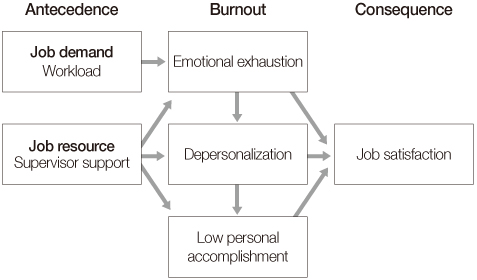
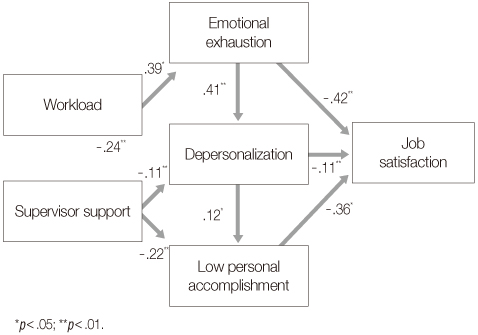
Figure 1
Conceptual framework.
Figure 2
Path diagram of the hypothetical model.
Figure 1
Figure 2
Analysis of Burnout and Job Satisfaction among Nurses Based on the Job Demand-Resource Model
Means and Correlations among Variables
Goodness Fit Indices for the Hypothetical Model
GFI=Goodness of fit index; AGFI=Adjusted goodness of fit index; CFI=Comparative fit index; RMSR=Root mean squared residual; NFI=Normed fit index; IFI=Incremental fit index.
Standardized Direct Effect, Indirect Effect, and Total Effect in the Hypothetical Model
SMC=Squared multiple correlation.
Table 1
Means and Correlations among Variables
Table 2
Goodness Fit Indices for the Hypothetical Model
GFI=Goodness of fit index; AGFI=Adjusted goodness of fit index; CFI=Comparative fit index; RMSR=Root mean squared residual; NFI=Normed fit index; IFI=Incremental fit index.
Table 3
Standardized Direct Effect, Indirect Effect, and Total Effect in the Hypothetical Model
SMC=Squared multiple correlation.
 KSNS
KSNS
 E-SUBMISSION
E-SUBMISSION


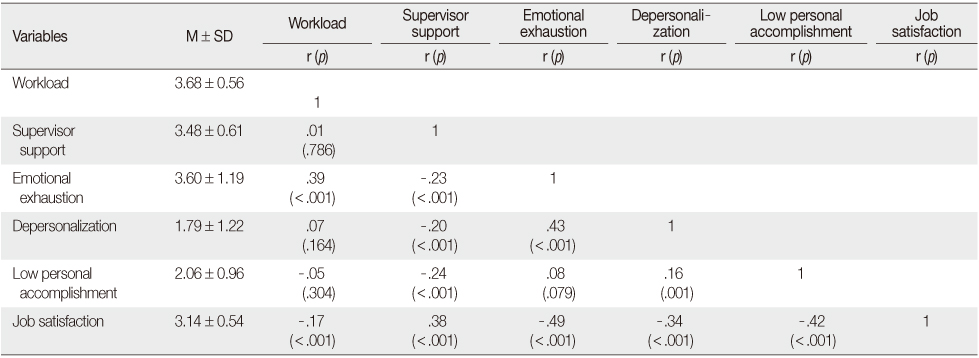
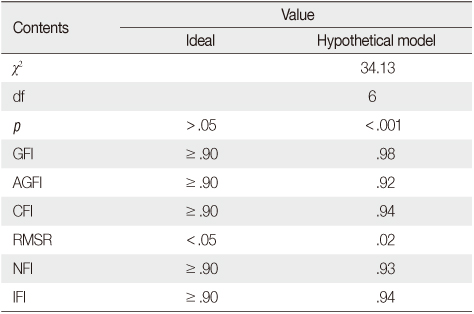
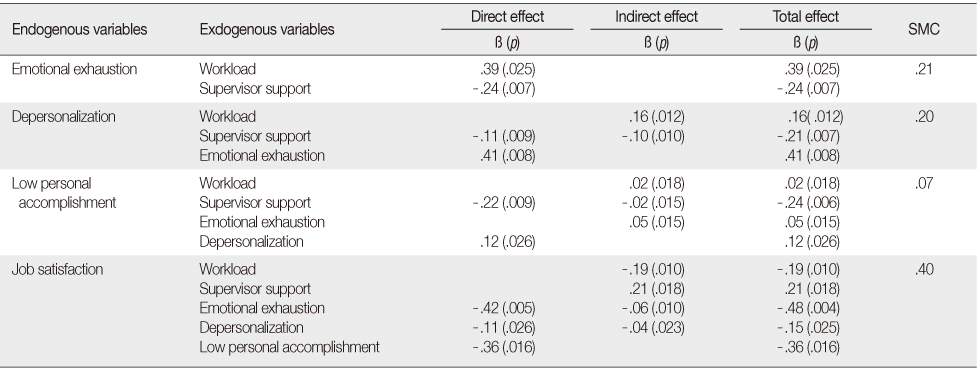
 Cite
Cite

